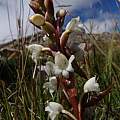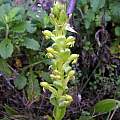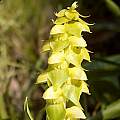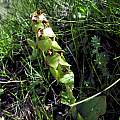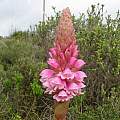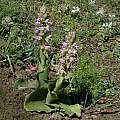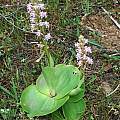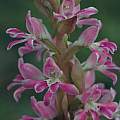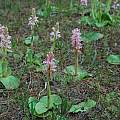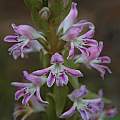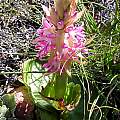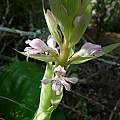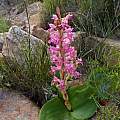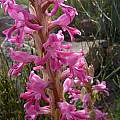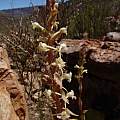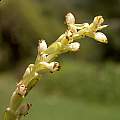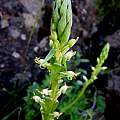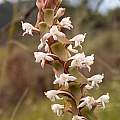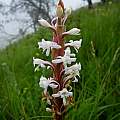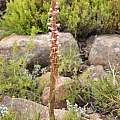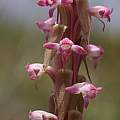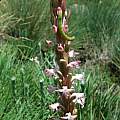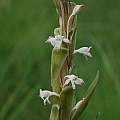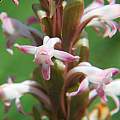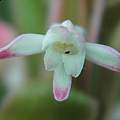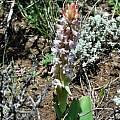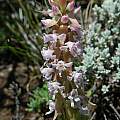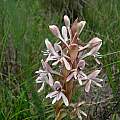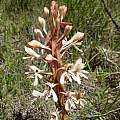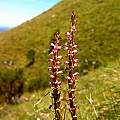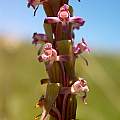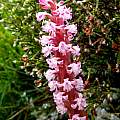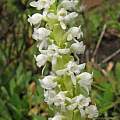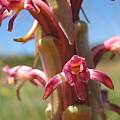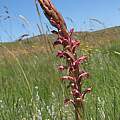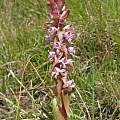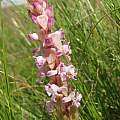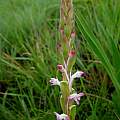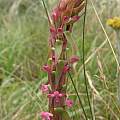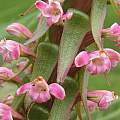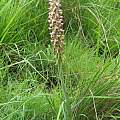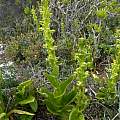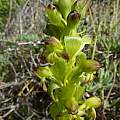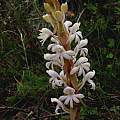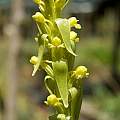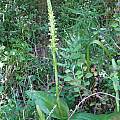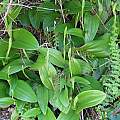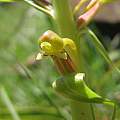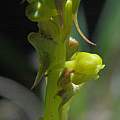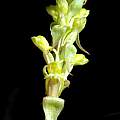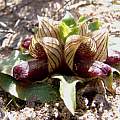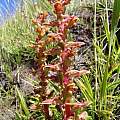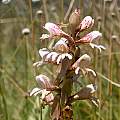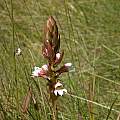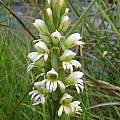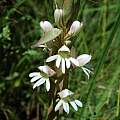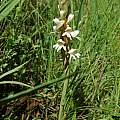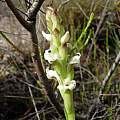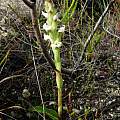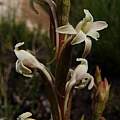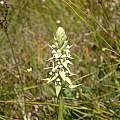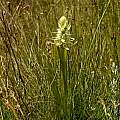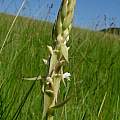Satyrium is a genus in the Orchidaceae family found in Africa, India, and China. These are terrestrial orchids with underground tubers and a lip that forms a hood. Satyrium species are deciduous, winter or summer growing. The tubers are annually replaced. Oval shaped leaves can be flat on the ground or in a raised spreading position. More information about this genus can be found on this web page entitled SA Orchids: Satyrium
Satyrium acuminatum Lindl. is a widespread South African species distributed from Swellendam to the Eastern Cape where it grows in rocky sandy soil. It grows to 35 cm high and flowers late spring to summer. Two leaves are pressed flat to the ground and the white to pink flowers have a strong clove-like scent. Photo from the book Plants of the Klein Karoo courtesy of Jan and Anne Lise Schutte-Vlok.
Satyrium bicorne (L.) Thunb. grows on sandy flats, lower hills, and slopes in the Western Cape from the Gifberg to the Peninsula and along the south coast to Knysna, South Africa. It grows from 30 to 50 cm and has 2 prostrate oval basal leaves, sheathing stem leaves, and greenish yellow flowers with brown to reddish spots. Sepals and petals are partly fused and united to the lip; the lip is helmet shaped and the spurs are slender and curved. This species is strongly spice scented and flowers from September to November. Photo taken by Bob Rutemoeller in Silvermine, Southwestern Cape.
Satyrium bracteatum (L.f.) Thunb. is a species found both in winter and summer rainfall areas of South Africa. Height: to about 35 cm. Photos by Cameron McMaster. The second was taken on Gaika's Kop.
Satyrium carneum (Dryand.) Sims is a South African winter rainfall species that grows among dune vegetation, in coastal fynbos on hills and ridges, on moist to dry sands and limestone from the Cape Peninsula to Riversdale. It grows from 30 to 70 cm with 2 basal leaves and sheathing stem leaves and pale to deep rose pink, rarely white flowers. Sepals and petal are separate, tips curved down, and the lip helmet shaped. Flowering is from September to November. Photos from Cameron McMaster taken in the Overberg.
Satyrium cristatum Sond. is a summer rainfall species found in moist or marshy grassland up to 2400 m from the Eastern Cape to Limpopo. South Africa. It grows from 14 to 40 cm with spreading basal leaves and a dense slender spike of greenish to creamy white flowers blotched and streaked red. Flowering is from January to February. Photo from Cameron McMaster taken at Aurora Peak, Maclear.
Satyrium erectum Sw. is a widespread winter rainfall species found on dry sandstone, and clay flats from Namaqualand to the southwestern Eastern Cape, South Africa. Growing to about 30 cm, it has 2 ovate-elliptic basal leaves that are flat on the ground and 11 to 37 sweetly smelling pink flowers in a dense raceme. Flowers have darker tinges and spots on the petals. Photos taken by Bob Rutemoeller and Mary Sue Ittner near Villiersdorp and between Nieuwoudtville and Vanrhynsdorp.
The first photo taken by Bob Rutemoeller in the Bontebok National Park. The next three photos taken by Cameron McMaster. The first one was taken in the Overberg and the next two in Namaqualand.
Satyrium humile Lindl. is found on stony sandstone slopes from the Western Cape to the Little Karoo, South Africa. Growing to 40 cm, it has two oval leaves spreading on the ground and flask like stem leaves. The flowers are in a dense raceme , pale cream tinged green, pink or brownish. This species flowers in spring, mainly after a fire. Photo from the book Plants of the Klein Karoo courtesy of Jan and Anne Lise Schutte-Vlok.
Satyrium ligulatum Lindl. has a wide distribution in South Africa in both the winter rainfall and the summer rainfall areas. It is found in coastal scrub, woodlands and moist to marshy flats among grass at elevations of 70 to 2000 m in full sun. It is winter-growing, blooming in spring with yellowish-green to white fragrant flowers that are tinged purple. Plants vary in size from small to mid size and number of flowers with 1 to 4 lower ground hugging leaves grading up the stem. Height range: 15-50 cm. Photos by Cameron McMaster. The second one was taken at Naude's Nek.
Satyrium longicauda Lindl. is a summer rainfall species that grows in grassland, rocky areas and marshes from the Southern Cape of South Africa to tropical Africa. It has white to pink sweetly scented flowers in a dense spike. Height range: 15-65 cm. Photos #1-4 were taken by Cameron McMaster. The first three photos were taken at Mt. Kubusie. Photo 4 was taken at Satansnek Pass. Photos 5-6 were taken January 2012 by Christopher Whitehouse at Gaika's Kop.
Photos taken at Maclear and Naude's Nek by Mary Sue Ittner.
Satyrium longicolle Lindl. is a species that grows on damp sandstone slopes in both the summer and winter rainfall areas from the Southern to Eastern Cape of South Africa. It is winter growing, blooming late spring, often after a fire. Flowers are in a dense spike, white to pink with darker streaks. Photos by Cameron McMaster.
Satyrium neglectum Schltr. is a summer rainfall species usually found scattered in small colonies in moist grassland from the Eastern Cape of South Africa to Tanzania. It has two basal leaves grading into floral bracts that are strongly deflexed, jade green, suffused pink. The white to dark or light pink medium to small sweetly scented flowers are in a dense spike adjacent to the leaves. Flowering is from January to February. Photographs by Cameron McMaster taken in the Eastern Cape. Height range: 25-80 cm.Photos 1-2 were taken at Mt. Thomas, photos 3-4 at Naude's Nek and photos 5-6 near Tordoon.
Photo 1-2 were taken at the Mafika Lisiu Pass, Lesotho, photo 3 at Satansnek Pass, photo 4 at Dohne Peak, and the last two at Aurora Peak, Maclear.
Satyrium odorum Sond. is a winter rainfall species often found among rocks in damp places from the west coast of the Western Cape to Knysna, South Africa. It has broad fleshy leaves, with the lower two spreading on the ground and pale yellow or greenish strongly scented hooded flowers. It flowers August to November. Height range: 20-50 cm. Photos taken near Jacobsbaai by Cameron McMaster.
Satyrium pallens S.D.Johnson & Kurzweil is found on dry rocky sandstone slopes and karroid scrub from the Northwest Cape to the Little Karoo, South Africa. Growing to 50 cm high, it has two prostrate fleshy leaves dry at flowering and creamy white to light pink flowers with long spurs that curve downward. It flowers in spring (October). Photo from the book Plants of the Klein Karoo courtesy of Jan and Anne Lise Schutte-Vlok.
Satyrium parviflorum Sw. is known as the Devil Orchid. It is found in moist or dry grassland, among rocks from the Southern Cape to the Eastern Cape, South Africa and in tropical Africa. It has yellowish green small, densely packed flowers, is variable in size. Height: to about 35 cm. Photos #1-3 by Cameron McMaster in the Eastern Cape. Photo 4 was taken at Satansnek Pass. Photo #5 and #6 taken by Mary Sue Ittner and Bob Rutemoeller at Naude's Nek.
Satyrium pumilum Thunb. occurs in seeps on sandstone, granite or clay from Namaqualand to Riversdale, South Africa. Growing up to 3 cm tall from a rosette of 3 to 5 fleshy leaves, it has dull green yellow large flowers marked with dark maroon that are unpleasantly scented and pollinated by carrion flies. It flowers in spring (September to December). Photo from the book Plants of the Klein Karoo courtesy of Jan and Anne Lise Schutte-Vlok.
Satyrium pygmaeum Sond. is a widespread species found on wet mossy ledges from the Western to the Eastern Cape, South Africa. Growing up to 20 cm tall and flowering from late spring to summer (October-November), this species has dull yellowish green tinged pale to dark purple to dull red flowers and spreading upright slightly folded leaves. Photo from the book Plants of the Klein Karoo courtesy of Jan and Anne Lise Schutte-Vlok.
Satyrium sphaerocarpum Lindl. is found in moist grassland from the Eastern Cape of South Africa to Mozambique. This tuberous plant grows to 50 cm. It has large white to cream few or many flowers that are streaked dark reddish brown to purple. Photos by Cameron McMaster taken at Dohne Peak and Maclear and by Mary Sue Ittner taken at Maclear.
Satyrium stenopetalum Lindl. is found in the winter and summer rainfall areas of South Africa in open stony marshy or dry places on coastal forests from Knysna to Humansdorp at elevations of 50 to 700 m. Growing to about 34 cm, it has erect leathery, stiff leaves clasping a reddish stem. The fragrant flowers are very pale creamy or greenish-white with long spurs. Flowering is in spring, from October to December. The first two photos from Cameron McMaster. The last photo from the book Plants of the Klein Karoo courtesy of Jan and Anne Lise Schutte-Vlok.
Satyrium trinerve Lindl. is a summer rainfall species found on marshy ground from the Eastern Cape of South Africa to tropical Africa. Bracts are green with broad white margins and spread horizontally. Flowers are white and yellow in a dense spike. Height: to about 1 m. Photos by Cameron McMaster taken at Dohne Peak and Maclear.
